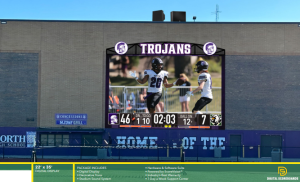March Madness inequality is extreme, yet somewhat justifiable
April 8, 2021
Athletes participating in the NCAA Women’s March Madness basketball tournament were outraged when they discovered they were given far fewer luxuries than male athletes competing in the Men’s March Madness tournament. From things such as weight rooms, food, and apparel, the women were given far less from the NCAA.
The difference in what the men and women received is eye-opening. It’s not right to give the men the amount of benefits they received, and give minimal to the women. The NCAA should have given the women more or given the men less. The gap was too extreme, it should have been narrowed down one way or another. However, before you say the men and women deserve equal treatment from the NCAA, take a look at some of the numbers, and see why the NCAA did what they did.
Men’s basketball is the primary “money maker” for the NCAA as a whole. Bringing in over $700 million on average each March, men’s basketball makes more money than any other collegiate sport. In 2019, the men’s tournament brought in $1.05 billion.
On the contrary, the women’s tournament makes far less money than the men’s, and the NCAA loses money through women’s basketball every season. The women’s tournament brings in about $35 million a year. However, NCAA president Mark Emmert recently shared in an interview that even after the tournament, the NCAA loses 14 million dollars throughout the women’s season. This is due to the costs of funding a national basketball league and the lack of revenue from ticket sales and viewers of women’s basketball.
It seems evident that men’s basketball is far more valuable to the NCAA, and rightfully so. While I would love to see gender equality in sports, it seems unreasonable to me to treat a multi-million dollar tournament the same as one that ultimately puts the organization in debt.
I will say, the treatment gap is pathetic on the NCAA’s part. But at the end of the day, the men’s teams fund the women’s tournament, and the women’s tournament loses money. Before female participants call the NCAA “unfair” or “unjust”, they should keep in mind that they’re talking about an organization that, for a lack of better words, donates money to give them their only opportunity to play, while they make the organization zero profit in return.
The argument will always be made that women’s college basketball can’t be treated equal to men’s until they make similar revenue. If you want to see more equality, watch the women’s March Madness tournament. So many people say they want the NCAA to treat the men’s and women’s tournaments equally, yet they can’t recall one match up in the women’s bracket. It’s one thing to say you’re an advocate for gender equality in sports, it’s another to do something about it.
Gender inequality in sports is prevalent at all levels, not just collegiate and professional. We see it here at DGN too. This is a problem with such an easy solution, it’s just a matter of us taking action.
Some of our most successful DGN teams in years past have been girls’ teams: girls’ basketball won conference this year, so did gymnastics, and in 2018, our girls’ volleyball team took second in the state championship. Women’s teams at all levels can’t be treated the same as men’s teams if the men’s teams attract triple the money and fans. So if you want to do something about gender inequality in sports, go to a girls’ lacrosse or soccer game this spring, fill out a women’s march madness bracket and tune into games, watch a Chicago Sky game. Every viewer makes a difference, and if we all give women’s sports the appreciation we believe they deserve, maybe the NCAA will too.

























